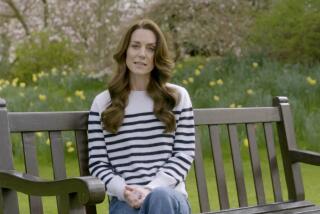National Portrait Gallery explores the many faces of Queen Elizabeth
LONDON--Since her coronation in 1952, Queen Elizabeth II has been painted, photographed and deconstructed more than anyone on Earth. A billion people carry her likeness around in their pockets every day -- not as a totem or religious icon but rather more practically as something to trade for milk or diapers.
Her station and her refusal to express an opinion on anything in public mean we all know what she looks like, some of us may have even shaken her hand, but only a handful of people really know her.
Paul Moorhead explores this tension between artifice and reality as well as charting changes in the way the Queen has been represented and perceived since her coronation in the exhibition called “Queen: Art & Image 1952-2012.” Following stops in around Great Britain, the collection is now home at the National Portrait Gallery in London until Oct. 21.
PHOTOS: Images from the Queen Elizabeth II exhibition
In the essay that accompanies the exhibition, Moorhead writes, “representing the Queen pictorially is nothing new. But in the last 60 years, the vast proliferation of images of the Queen, in all media, surpasses historical antecedents.”
The ubiquity of her image and refusal to register any sort of opinion in public have made the Queen – or at least her likeness – the ideal blank canvas on which artists can project their own feelings about class, power, authority, loneliness and whatever else comes to mind.
Out of the millions of available images, Moorhouse has chosen 60 he feels best represent changes in how we see the Queen and also how she wishes to be seen.
PHOTOS: Images from the Queen Elizabeth II exhibition
In 1952, Dorothy Wilding photographed the Queen as impossibly glamorous, like a 1940s Hollywood starlet. Eight years later, she posed formally but softly, cradling an infant Prince Albert and in 1969, the Queen stood in a red cape, head held high as Pietro Annigoni painted her “alone in the problems of her responsibility.”
Accepting a royal commission is prestigious but can be a two-edged sword. German photographer Thomas Struth was commissioned to photograph the Queen and her husband, Prince Philip, to mark the Diamond Jubilee.
“I thought maybe it was going to ruin my career or maybe everyone will only want to talk about the royal portrait,” Struth told the BBC, “but in the end I could not reject such an opportunity…to enter the ring of this historical activity and see what my contribution might possibly be.”
Of course, a commission is not needed to use the Queen’s image. Jamie Reid famously incorporated a newspaper image of the Queen along with the Union Jack in the album art for the Sex Pistol’s 1977 single “God Save the Queen.” The decline of deference in modern mores is further illustrated by Justin Moritimer’s 1998 painting in which the Queen’s head is separated from her body.
After walking through five smallish rooms of photographs, paintings, mixed-media art and even holograms, the only thing more clear on the way out is the Queen’s gift of being whomever you wish her to be. Not even Madonna has managed that.
ALSO:
LACMA cuts hours and employees
Rolling Stones hires Shepard Fairey for 50th-anniversary logo
Stolen atlas with first map of California is returned to Sweden
More to Read
The biggest entertainment stories
Get our big stories about Hollywood, film, television, music, arts, culture and more right in your inbox as soon as they publish.
You may occasionally receive promotional content from the Los Angeles Times.






